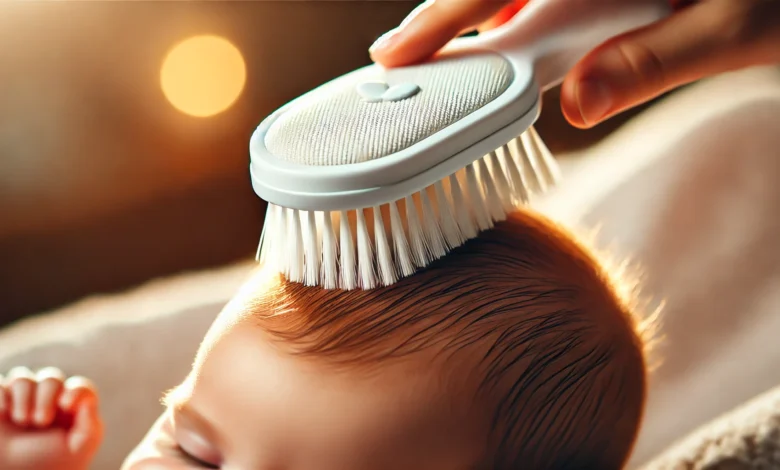Cradle Cap Brush: Gentle Care for Your Baby’s Delicate Scalp

Introduction
Feeling stressed about your baby’s cradle cap? Read on to find out how you can treat this condition without making your child uncomfortable.
Milia or cradle cap commonly occurs in newborns, causing the baby’s scalp to become scaly and sometimes greasy. Most of the time, it goes away without treatment but if you want to hasten the process, there is a cradle cap brush that you can use to brush off the flaky skin without causing the baby’s skin to become sore. In this article, we’ll provide all the essential information parents need about using a cradle cap brush on their baby’s head.
What is Cradle Cap and Its Impact on Your Baby?
Why Use a Cradle Cap Brush for Your Baby’s Scalp?
A cradle cap brush massages a baby’s head and effectively removes the flakes that characterize cradle cap. It is not a usual brush that has stiff bristles on the head; rather it is a massaging brush with bristles on scalp. The cradle cap brush removes excess sebum from an infant’s scalp and helps reduce the likelihood of future cradle cap.
How to Use a Cradle Cap Brush: Step-by-Step
Cradle cap brush is convenient and painless to apply on the head of a baby. The first wash is done using baby soap and water more to especially the head of the baby. Wring the towel and gently pat the baby’s head with the towel such that there will be only a little dampness, then take the cap brush to massage the areas in circular motions. This assists in lifting flacks from the scalp allows them to fall appropriately on the shirt. Wash off the dead skin, and if the skin is dry, as is often the case after brushing, apply baby moisturizer, when necessary. That is why, for a better result, it better to make this process from time to time.
Choosing the Right Cradle Cap Brush: Key Tips
As is the case with most of the cradle cap brushes in the market, there are variations in quality and design. Choose a brush the bristles of which have rounded tips for purposes of ensuring that you do not hurt your baby in anyway. The handle should be comfortably griable all times; more so when the parent handling the baby has wet hands due to washing. At times the brushes are also designed having two handles, one side which is used to brush the hair of a baby and the other side which is used to massage the baby’s head softly. Ensure the brush material is safe for consumption; this is the foundation for choosing the right brush.
Extra Tips for Managing and Preventing Cradle Cap
Therefore, it is possible to control or prevent cradle cap, apart from the use of the cradle cap brush, in other ways. It directed that you wash the baby with the mild baby soap and each time you massage the scalp of the baby. Avoid applying very strong products to the skin of the head since this may cause dry up of the skin. Applying ‘safe’ oil or cream on the skin of the baby in addition also help in preventing formation of more flakes on the head of the baby. However, you should do this in consultation with a pediatrician if the condition worsens or persists.
What is the best way to clean a cradle cap brush?
Rinse the brush with warm water and mild soap after each use.
How often should I use a cradle cap brush?
Use the brush 2-3 times a week or as recommended by your pediatrician.
When should I stop using a cradle cap brush?
Stop once the cradle cap has cleared or if your baby’s scalp becomes irritated.
Conclusion
A cradle cap brush is a perfect tool for taking care of your baby’s hair; this tool can be efficiently used for removing the flakes common for cap without any irritation. If you maintain a good brush and practice good care on your baby, then you should not be worrying about cradle on your baby. Just a reminder: patience and continuity are your big friends, and it’s always a good idea to check with your pediatrician. As with any condition, if you have the correct equipment and information then cradle cap is not difficult to control and your baby will be able to have a healthy, happy scalp.



